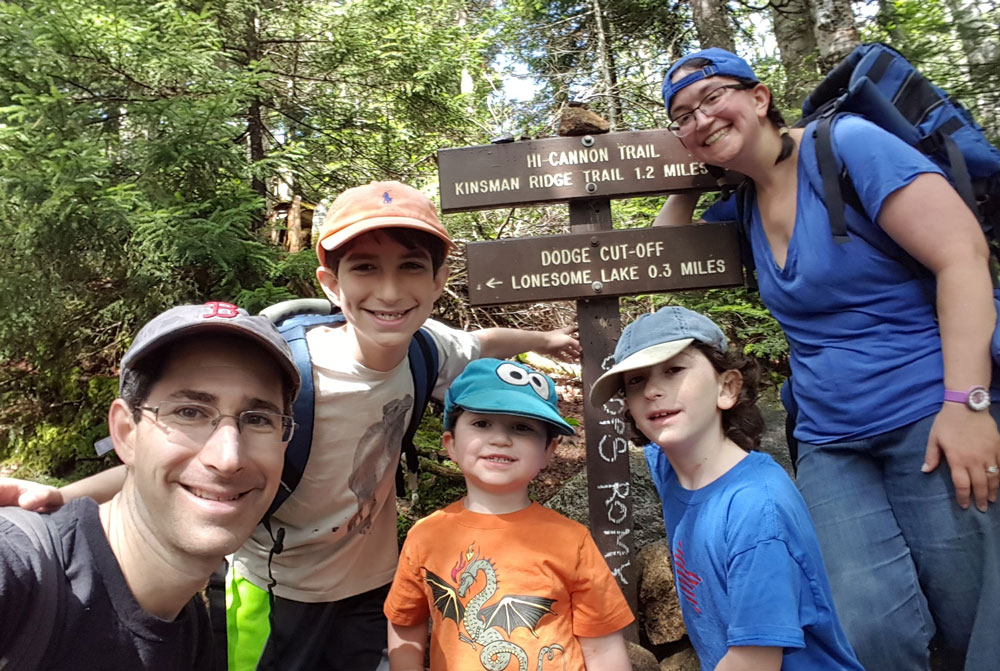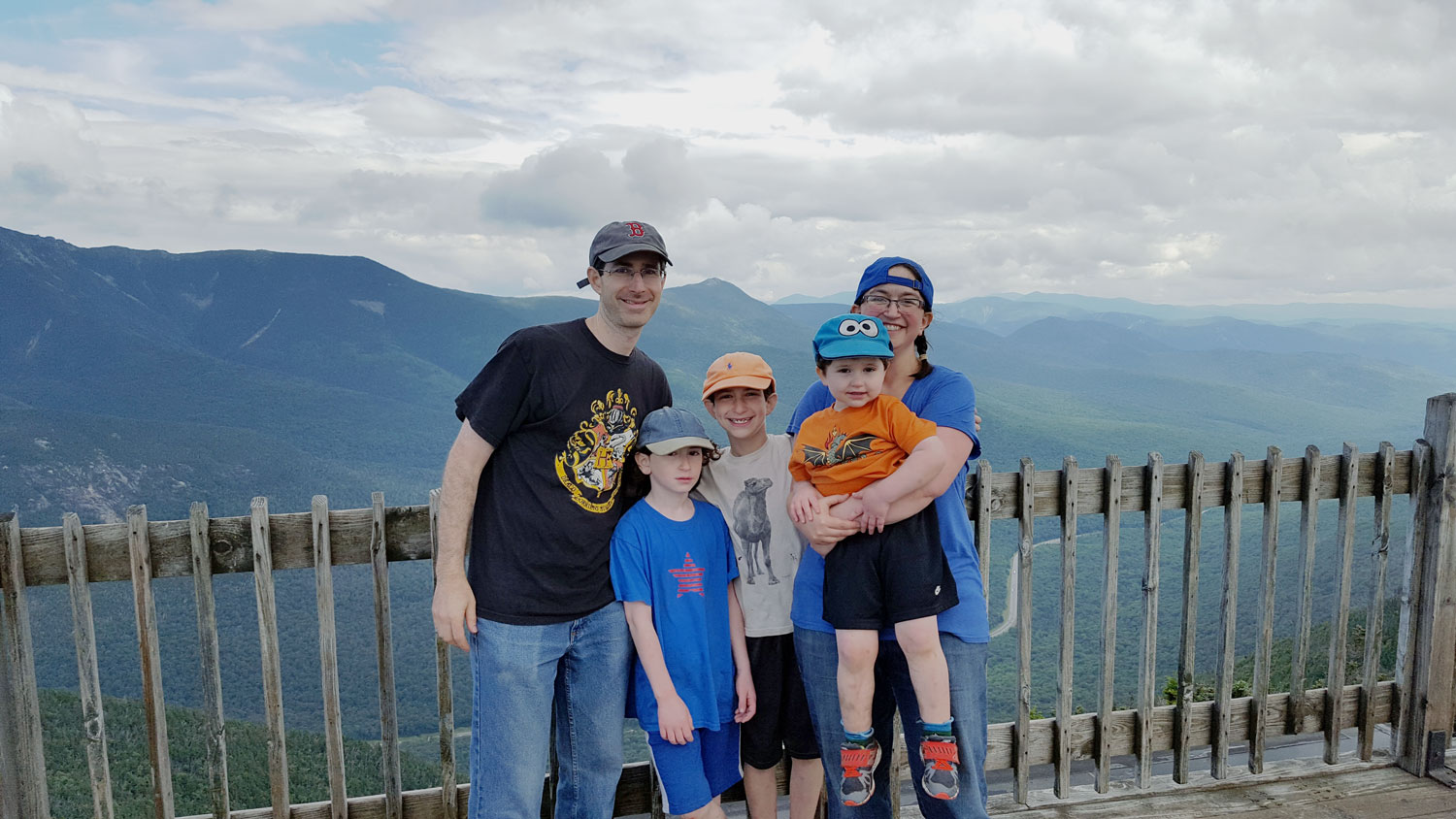Genesis Jacob’s Ladder: Finding Wonder in Life’s Highs, Lows, and Middles Too

Parashat Vayeitzei (Genesis 28:10-32:3)
A few summers ago, my family was camping in Franconia Notch in New Hampshire’s White Mountains. We had spent many hours hiking up Cannon Mountain. As we reached the top, we climbed the lookout tower which enables one, on a clear day, to see for miles around into several states. Upon seeing the view, our youngest son shouted out in Yiddish (our family language), word by word, “Ikh! Ken! Zen! Di! Gantse! Velt!” “I! Can! See! The! Whole! World!”
I think of my then almost-four-year old’s natural expression of wonder as being much like Jacob’s exclamation in our Torah portion, when he awakens, awestruck after his dream of angels ascending and descending a ladder, and says (Gen. 28:17) “Ma nora hamakom hazeh! Ein zeh ki im beit Elohim, v’zeh sha’ar hashamayim!” “How awe-inspiring is this place! This is none other than a house of God, and that is the gate of heaven!” I don’t always shout when I reach the top of a mountain, but this sentiment, this awe and wonder, is exactly why I like to drag myself, and sometimes my family, up mountains, when given the opportunity. One can sense God’s presence anywhere and everywhere, but how can you not sense God’s presence on a mountain top, when you feel like you’re looking out over the whole world, and m’lo chol ha’arets k’vodo, the whole world is full of God’s glory.
A mountain top, literally a peak experience, may be especially conducive to communing with the Divine, but where does that leave us when we’re coming down off of that high? In the opposite situation, when we are feeling low, dealing with illness, setbacks, grief, stress, and estrangements, we may feel alienated from God or abandoned. Jacob’s encounter with God in our parsha can also serve as a model for reconnecting with God when we are in trouble. Jacob is alone, cut off from his family, fearing for his life, without material possessions, sleeping in the desert with a rock for a pillow. Sometimes, like Jacob, we may encounter God when we least expect it, as expressed in Gen. 28:16: “Vayikatz Ya’akov mish’nato vayomer: ‘Achein, yesh Adonai bamakom hazeh, v’anochi lo yadati.’” “Yaakov awoke from his sleep and said: ‘Why, YHWH is in this place, and I, I did not know it!’” This rekindling of a relationship with the Divine when we need it most may pull us up from the depths, providing us a way out of our narrowest places.
If both our emotional peaks, and paradoxically, our nadirs, may lead us to connect with something greater than ourselves, what about the majority of the time when we’re feeling middling? In Jon Levenson’s chapter in “Jewish Spirituality from the Bible through the Middle Ages (edited by Hebrew College Rector Rabbi Art Green),” he sets up two contrasting Jewish ideas of spirituality which I think may guide us through the middle: the “settlement tradition” and the “Sinai tradition.”
The settlement tradition is the quest, unfulfilled in the Torah, to reach and settle the land of Israel. This idea embodies striving for achievement, improvement, and enlightenment by trying to reach new territory. Even if and when one attains one’s goal, one then needs to set one’s sights farther. What Levenson calls the “Sinai tradition” or the “priestly tradition” is an enduring means of access to God, forged at Sinai, and kept up through daily rituals — sacrifices in Biblical times, and prayer, study, and mitzvot today — all ways of keeping the fires burning through repetition, constancy, and intimacy. This method of connection is less dramatic but more compatible with day-to-day life. Levenson says that both the distant objectives and the reachable routines are necessary, and that the two spiritual paths of pursuing long-term dreams and cultivating daily habits can complement and amplify each other. If we also view his two categories as a distinction between peak experiences and everyday ones, I would propose that Sinai itself —- the ultimate peak experience — belongs in both categories, as a symbol of intimate Divine-human relationship and of an experience, far-off in time and place, that we can aspire to and yearn to recapture.
The Mishna in Berachot 9:2 includes this instruction among blessings to be said upon viewing various wonders of the world: “[Upon seeing] mountains, hills, seas, rivers, and deserts, say, “Baruch oseih ma’asei v’reisheet.” “Blessed is [the One] who makes the works of Creation.” In medieval times, Rabbi Abraham ben Moses (Maimonides’ son) advised seeking out these places, saying: “In order to serve God, one needs access to the enjoyment of the beauties of nature, such as the contemplation of flower-decorated meadows, majestic mountains, flowing rivers…for all these are essential to the spiritual development of even the holiest people.”
May we have the opportunity to follow Rabbi Abraham ben Moses’ advice to seek beauty in the natural world. And may connecting with the Divine through physical and emotional highs remind us of our ability to connect at unexpected times, when we are feeling especially low, or ensconced in the routines of our day-to-day existence. We can’t always be on a mountain top — even the angels on Jacob’s ladder have their ups and downs — but may the miracles of creation that we witness on the high vistas remind us of the everyday miracles that are always available to us, should we open our eyes to them.
Ken Richmond has been the Cantor of Temple Israel of Natick since 2006, and has also served since then as adjunct faculty in Hebrew College’s cantorial program. He is currently using sabbatical time to study at Hebrew College’s Rabbinical School.


